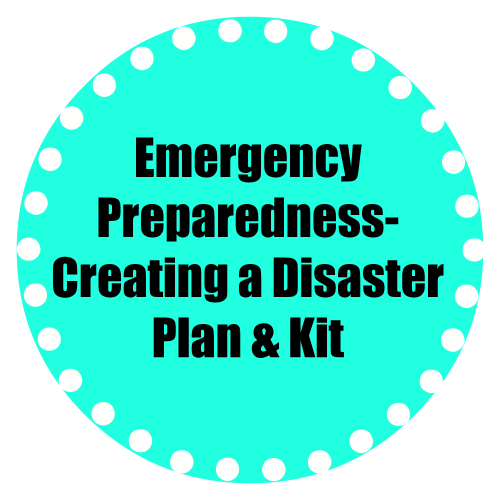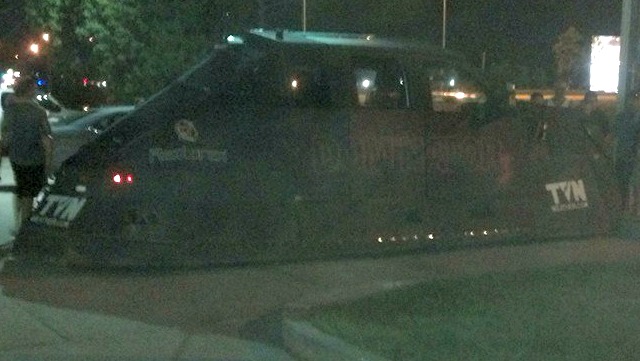This last week we experienced our first bout of severe storms in my area of the year. In the Midwest, tornadoes are common but as areas become more urban it seems that they are becoming increasingly dangerous, costly, and deadly.
To be honest, I usually don’t get very excited about tornadoes. If the sirens go off, we head down to our yucky unfinished basement and stay there for the smallest amount of time possible. If I’m really feeling like it’s going to storm and there’s time, we go over to my mother-in-laws or my mom’s house because their basements are nicer places to hang out! However, last week after seeing the TVN Dominator storm chasing vehicle in our town, I decided it was time to start working on our own disaster kit. Maybe I’m getting older, more aware, or am just more worried than I used to be but emergency preparedness has become more important to me than in the past. (I’ve also noticed that when these vehicles show up in the area, usually there is a reason why and it’s usually not good after the storm!)
Anyway, back to being prepared for an emergency. One of the Facebook groups I belong to were discussing the upcoming storms and it occurred to me that whether your area deals with tornadoes or hurricanes, we all need prepared for natural disasters. These events can creep up in minutes or sometimes there is advanced notice but either way, if they occurred to you, I’m sure that you would want to be prepared with a plan and disaster kit.
Here are the items taken directly from the Federal Emergency Management Agency (FEMA) that you should include in your kit (and it should be assembled way ahead of when you will need the items because you never know if you will have time to prepare when they are coming!)
- Water, one gallon of water per person per day for at least three days, for drinking and sanitation
- Food, at least a three-day supply of non-perishable food
- Battery-powered or hand crank radio and a NOAA Weather Radio with tone alert and extra batteries for both
- Flashlight and extra batteries
- First aid kit
- Whistle to signal for help
- Dust mask to help filter contaminated air and plastic sheeting and duct tape to shelter-in-place
- Moist towelettes, garbage bags and plastic ties for personal sanitation
- Wrench or pliers to turn off utilities
- Manual can opener for food
- Local maps
- Cell phone with chargers, inverter or solar charger
Once you have gathered the supplies for a basic emergency kit, FEMA recommends adding the following items:
- Prescription medications and glasses
- Infant formula and diapers
- Pet food and extra water for your pet
- Cash or traveler’s checks and change
- Important family documents such as copies of insurance policies, identification and bank account records in a waterproof, portable container. You can use the Emergency Financial First Aid Kit (EFFAK) (PDF – 977Kb) developed by Operation Hope, FEMA and Citizen Corps to help you organize your information.
- Emergency reference material such as a first aid book or free information from this web site.
- Sleeping bag or warm blanket for each person. Consider additional bedding if you live in a cold-weather climate.
- Complete change of clothing including a long sleeved shirt, long pants and sturdy shoes. Consider additional clothing if you live in a cold-weather climate.
- Household chlorine bleach and medicine dropper – When diluted, nine parts water to one part bleach, bleach can be used as a disinfectant. Or in an emergency, you can use it to treat water by using 16 drops of regular household liquid bleach per gallon of water. Do not use scented, color safe or bleaches with added cleaners.
- Fire extinguisher
- Matches in a waterproof container
- Feminine supplies and personal hygiene items
- Mess kits, paper cups, plates, paper towels and plastic utensils
- Paper and pencil
- Books, games, puzzles or other activities for children
Here are the items that I personally would recommend you add to your disaster kit:
- A plan of exactly what you will do in an emergency situation. This plan needs to be known by each member of your household. My kids are scared of tornadoes. Really scared. However, I’d rather talk to them about it and know that they need to go down to the basement if they hear sirens or weather radio going off than have them panic and not know what to do.
- Photos of your home and personal belongings. Pictures are important at loss time whether it’s a fire, tornado, or hurricane. This is for insurance purposes when you need to list all the items that you own (which is about impossible without added stress) and could be kept with your emergency documents and also in your safety deposit box.
- A disposable camera to take pictures of the storm AFTER it has happened for emergency purposes. If you don’t have power, you don’t need to waste your cell phone battery on photos. Also, it’s important to take pictures so if you have problems with your insurance company you have proof of the damage.
- Fill up your vehicles with gas. A friend recommended this one and I think it’s brilliant. Depending on your area, you may not be able to get gas after a disaster.
- Charge up and have with you: laptops, Ipads, all cell phones, and cameras.
- Something to help you dig out of the rubble- a shovel, etc.
- A backpack for each child. Include changes of clothing, medicine, and a “lovey” for each child. If you lose everything in a disaster there is a lot of comfort from having their favorite toy, blanket, stuffed animal, etc.
Here are the items FEMA recommends for a First Aid Kit:
- Two pairs of Latex or other sterile gloves if you are allergic to Latex
- Sterile dressings to stop bleeding
- Cleansing agent/soap and antibiotic towelettes
- Antibiotic ointment
- Burn ointment
- Adhesive bandages in a variety of sizes
- Eye wash solution to flush the eyes or as general decontaminant
- Thermometer
- Prescription medications you take every day such as insulin, heart medicine and asthma inhalers. You should periodically rotate medicines to account for expiration dates.
- Prescribed medical supplies such as glucose and blood pressure monitoring equipment and supplies
Non-prescription drugs:
- Aspirin or non-aspirin pain reliever
- Anti-diarrhea medication
- Antacid
- Laxative
Other first aid supplies:
- Scissors
- Tweezers
- Tube of petroleum jelly or other lubricant
I will admit that this list is overwhelming and will take time to complete but if you work on it a little at a time, it could not only make your life easier in a disaster but it could save your life!
What would you add to this list?





Thanks for the thorough list! I know I’m not as prepared as I should be.
This is a very good list. We are lucky to live in an area without major weather. However only 2 years a go a major tornado did touch down only an hours drive away from here, so you never know. I love the idea of photo’s of your personal belongings. We also have an external hard drive with all our family photo’s on it. In an emergency I can grab it and no matter what happens to our home I will have these memories.
Thank you for this helpful information on creating an emergency preparedness plan and kit. It’s good to know that the list of things to put in the kit is provided by the Federal Emergency Management Agency. I agree that it’s so important to assemble a kit as soon as possible because you never know when you might need it. I think it’s also important to have kits in multiple locations around your house and car, just in case.
Hello Jenny! Thank you so much for your article. I think it is very comprehensive. In my case, to stop bleeding, I keep skin super glues such as Dermabond or Vetbond in my first aid kit. I think these type of glues are very handy.
Thanks for your article, I greatly enjoy your posts.
Felix
One of the ways to shield your family and prepare for an emergency is to start with proper communication. A circle of relatives emergency verbal exchange plan is critical to making sure the whole own family is aware of who to contact, a way to reach each different, and where to meet up in an emergency.
Amazingly informative content you have here! I think it is important to always come prepared. Especially, when combating natural disasters that are sometimes unpredictable. Thank you for these tips! These will surely be helpful!